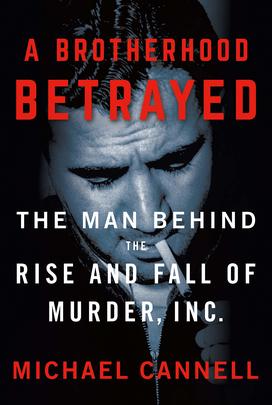Organized Crime Brought to Life by Michael Cannell ’82

In A Brotherhood Betrayed: The Man Behind the Rise and Fall of Murder Inc. (Minotaur Books), Michael Cannell ’82 traces the life of Abe Reles as he rose through the ranks of organized crime to become a prolific mobster. As Cannell chronicles, when Reles chose to switch sides the balance of power between the police and the mob shifted with him, with major consequences for New York City and beyond.
The author: Michael Cannell ’82 is the author of Incendiary: The Psychiatrist, the Mad Bomber and the Invention of Criminal Profiling; The Limit: Life and Death on the 1961 Grand Prix Circuit; and I.M. Pei: Mandarin of Modernism. He was an editor at the New York Times for seven years and has written for The New Yorker, The New York Times Magazine, Sports Illustrated, and many other publications. He lives in New York City.
Opening lines: Even from a distance the two men recognized the body. Thirty-five-year-old Abe Reles, kinky-haired and jut-jawed, had served for a decade as the assassin-in-chief for an underworld death squad loosely known as Murder, Inc. When the principals of a coast-to-coast organized crime network identified an informant in their ranks, or a foot soldier who breached their loyalty code, they passed a murder contract down to Reles, who either took up his weapon—gun, garrote, icepick—or, more often, delegated the job to lieutenants. A veteran detective called them “probably the worst ring of killers in American history.” Their victims died horrible deaths, gangster deaths. They dumped bodies like garbage in shallow lime pits or left them doubled-up and decomposed in the trunk of cars abandoned on lonely streets.
Dead men could not testify: such was Reles’s lurid strategy. The tactic worked for a decade. Then, in February 1940, Reles abruptly turned against his lifelong friends and closest compatriots in crime. He abandoned his career as an underworld assassin to become an informant—the most talkative and damning in mob history. In a series of marathon meetings conducted over coffee and sandwiches in the district attorney’s offices on the fourth floor of the Brooklyn Municipal Building, he disclosed to prosecutors the vast and intricate workings—the grudges and revenge, alliances and betrayals—of an elaborate criminal underground, a country-within-the-country, that law enforcement had previously only glimpsed in isolated pieces. Reles revealed another America hidden in shadow with its own banks and penal system, its own tax code and law enforcement. The history of organized crime had been written over the decades in increments based on court appearances and police logs. Now, for the first time, heroes and villains, potentates and snitches, were revealed in a single dark opera told with flourish by a key player.
Speaking like a streetwise stand-up comic, Reles confessed to eleven murders. He resolved several dozen more, including deaths unknown to the police. He brought all the dirty work out into the light with the relish of a natural storyteller. He recalled with cinematic detail victims hatcheted, cudgeled, set on fire, trussed and dumped in peaceful up-state lakes, macerated by bullets, and, in at least one case, buried alive. His accounts were almost too gruesome to be real.
Reles made vivid for prosecutors the whole sweeping epic of life and death in the mob, mostly in Brooklyn, but as far afield as Miami and Los Angeles. After two decades of dodging and defying the law, he lifted the lid for the first time on an entire underworld, with all its thuggery and casual cruelty.
Reles was the keystone, the Jenga piece, in a government push to end once and for all the mob’s long-reaching free hand in murder, racketeering, extortion, loan sharking, drug smuggling, prostitution, and gambling. District attorneys waged their campaign to restore law and order, but also to advance themselves professionally. Whoever busted the mob would earn a path to higher office. The mobster’s loss was the prosecutor’s gain.
In the months before he tumbled from that hotel window, Reles helped send four to the electric chair, including his two best friends. Now, in November 1941, the proceedings were poised to enter a weightier phase as prosecutors prepared to try the mob lords, men who would qualify for the Mount Rushmore of crime.
As the authorities battled to bring down the big bosses, the danger to Reles and other informants correspondingly intensified. It was known that the defendants or their allies still at large would try to arrange for Reles to die before he testified against them, before he could send them to the Sing Sing death house. Newspaper readers held their collective breath, waiting to see if layers of police protection could hold against the gathering forces of underworld revenge. Reles himself had told prosecutors that mob law decreed that “the squealer must die.”
The Brooklyn district attorney rented a ten-room wing of the Half Moon Hotel, known as the Rat Suite, where he sequestered and safe-guarded Reles and five other mobsters-turned-informants behind a steel door manned by a twenty-four-hour police guard. Lawyers in the D.A.’s office called them informants; their old street corner friends called them stool pigeons, canaries, and snitches.
Reles fell to his death hours before testifying in his biggest role, as the marquee witness in the trial of mob overlord Louis “Lepke” Buchalter. The police took up a saying: the canary sang, but could not fly. Like many expressions coined on New York streets, it was part wisecrack, part truth.
Police concluded that Reles died while escaping their custody, and newspapers initially reported it as such, but the ink had barely dried on afternoon papers before speculation began that Reles may not have gone out the window voluntarily. Did he fall, or was he pushed? And
who might have pushed him? As the months passed, clues implicating both police and city officials accrued. As the question heated up, the mayor himself came under suspicion.
The riddle of who might have murdered Abe Reles, and on whose order, remains one of great unanswered questions in the history of organized crime. The puzzle would lie at the heart of grand juries and a Senate inquiry, to no conclusive end. It would reverberate through police stations, party clubhouses, a mayoral mansion, all the way to the doors of the White House.
Review: “The definitive account of hit man Abe Reles … Cannell dials in the right level of detail in this grim story of violence, corruption, and the dogged efforts of law enforcement to break organized crime’s hold on New York City. Readers interested in a non-sensationalized treatment of a major chapter in American crime will be riveted.” –Publishers Weekly
[MOU1]For length, but I liked yours a lot!











No responses yet